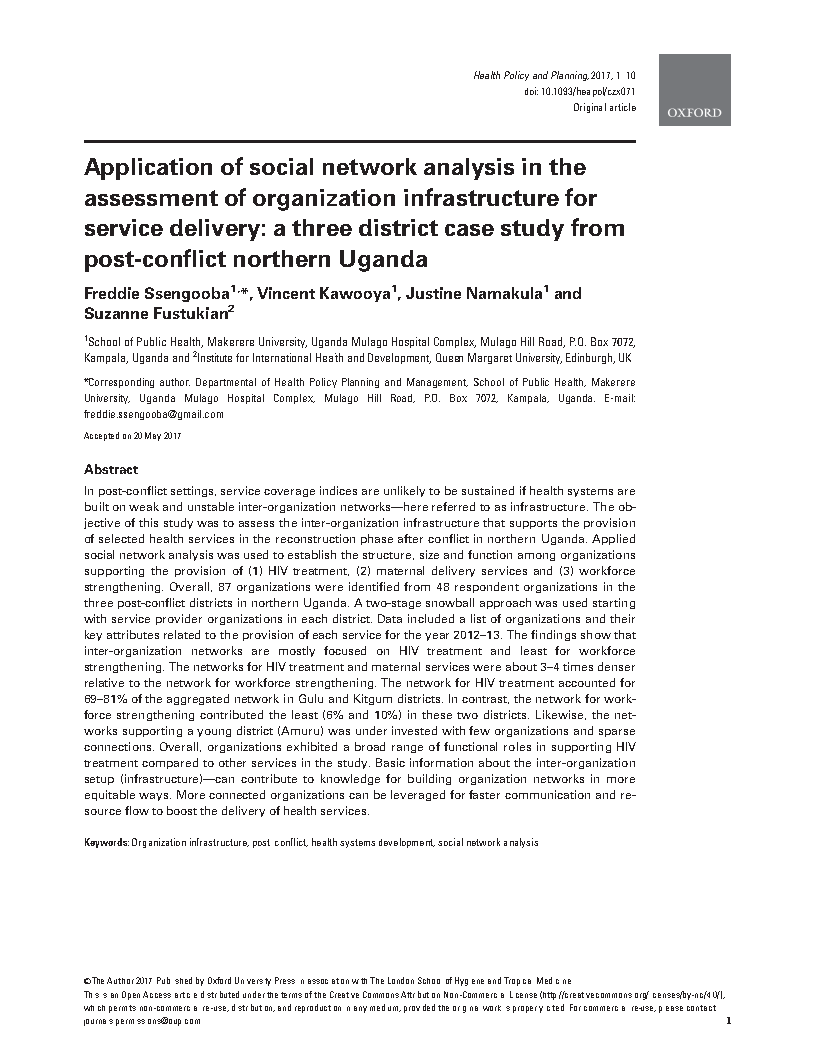Application of social network analysis in the assessment of organization infrastructure for service delivery: a three district case study from post-conflict northern Uganda
 Freddie Ssengooba, Vincent Kawooya, Justine Namakula and Suzanne Fustukian
Freddie Ssengooba, Vincent Kawooya, Justine Namakula and Suzanne Fustukian
Health Policy and Planning, 2017, 1–10 doi: 10.1093/heapol/czx071
This paper reports on ReBUILD’s research on aid effectiveness in northern Uganda, which assessed the inter-organisation infrastructure that supports the provision of selected health services in the reconstruction phase after conflict in northern Uganda. Using social network analysis, the study looked at the structure, size and function among organizations supporting the provision HIV treatment, maternal delivery services and workforce strengthening.
The authors conclude that basic information about the inter-organization setup can contribute to knowledge for building organization networks in more equitable ways, and that more connected organizations can be leveraged for faster communication and resource flow to boost the delivery of health services.
This study was led by Makerere University School of Public Health, ReBUILD’s partner in Uganda.
You can download the full paper here.
[A further paper has also been published from this study: Sub-national assessment of aid effectiveness: A case study of post-conflict districts in Uganda.]
Abstract:
In post-conflict settings, service coverage indices are unlikely to be sustained if health systems are built on weak and unstable inter-organization networks—here referred to as infrastructure. The objective of this study was to assess the inter-organization infrastructure that supports the provision of selected health services in the reconstruction phase after conflict in northern Uganda. Applied social network analysis was used to establish the structure, size and function among organizations supporting the provision of (1) HIV treatment, (2) maternal delivery services and (3) workforce strengthening. Overall, 87 organizations were identified from 48 respondent organizations in the three post-conflict districts in northern Uganda. A two-stage snowball approach was used starting with service provider organizations in each district. Data included a list of organizations and their key attributes related to the provision of each service for the year 2012–13. The findings show that inter-organisation networks are mostly focused on HIV treatment and least for workforce strengthening. The networks for HIV treatment and maternal services were about 3–4 times denser relative to the network for workforce strengthening. The network for HIV treatment accounted for 69–81% of the aggregated network in Gulu and Kitgum districts. In contrast, the network for workforce strengthening contributed the least (6% and 10%) in these two districts. Likewise, the networks supporting a young district (Amuru) was under invested with few organizations and sparse connections. Overall, organizations exhibited a broad range of functional roles in supporting HIV treatment compared to other services in the study. Basic information about the inter-organization setup (infrastructure)—can contribute to knowledge for building organization networks in more equitable ways. More connected organizations can be leveraged for faster communication and resource flow to boost the delivery of health services.